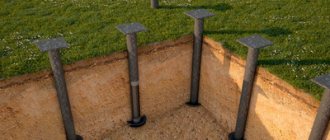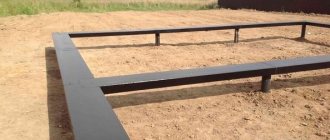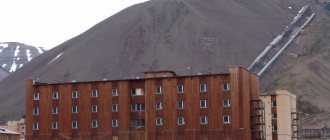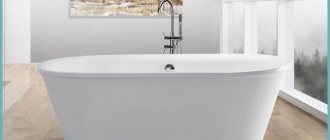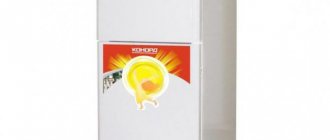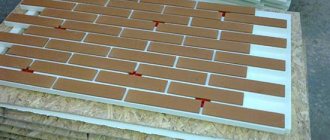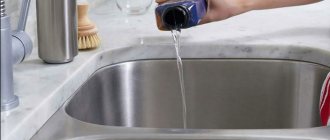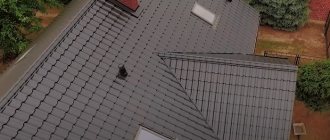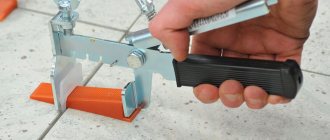The quality of the soil has a great influence on the choice of foundation and the entire construction technology in general.
In Russia there are a large number of problem regions where swampy, flooded or weak-bearing soil types predominate.
The use of a traditional foundation in such conditions is unacceptable, but pile types of support structures come to the rescue.
They ensure contact of the base with dense layers of soil and allow the construction of massive and heavy buildings without fear for their condition.
There are also lighter options for pile foundations, which include screw piles.
Foundation on screw piles
Screw piles are a supporting structure in the form of a system of metal pipes immersed in the ground with spiral blades welded at the bottom (photo below) . They play the role of cutting, similar to that done on screws.
The pointed conical tip allows the trunk to enter the ground more easily, and the blades perform the cutting function and in parallel serve as support units.
The submerged support is kept stationary due to the frictional force between the side walls of the pipe and the ground, as well as due to the load on the blades. The installation is carried out according to a certain scheme, forming the so-called. a pile field that ensures uniform load distribution across all shafts .
After immersion, the upper parts are trimmed to form a flat plane and tied with a load-bearing belt - a grillage.
It provides a supporting structure for the walls and evenly transfers the load to the pile system.
The functions of the grillage are close to the operation of a strip foundation, but the support for it is not the ground surface, but the upper ends of the vertical rods. To strengthen the structure, hollow pipes are filled with compacted concrete after installation, which makes them immune to possible lateral loads .
IMPORTANT!
Installation of screw piles does not require immersion until contact with dense layers of soil occurs. With sufficient depth, they quite reliably hold the building, being a hanging type of piles.
Creating walls in stages
When the frame is ready, it's time to work on the walls. First of all, you need to purchase insulation.
The choice of insulation for a frame house is huge:
- mineral wool
- Styrofoam
- liquid insulation in the form of foam, which hardens after a while
- glass wool
- bulk insulation (expanded clay, etc.)
Frame house wall
The standard insulation for frames is mineral wool or polystyrene foam.
They can be of different thickness, size and density. However, when choosing insulation, you must take into account that it must fit exactly between the frame beams.
That is, if you built a frame from 15 cm timber, then the thickness of the mineral wool, for example, should also be 15 cm.
The insulation should be positioned end to end, with no gaps between the beams.
On the outside of the house, the insulation is covered with a 20 cm overlap with waterproofing film. It will prevent moisture from entering the wall.
Insulation of a frame house
From the inside of the house, the insulation is also covered with a film, this time a vapor barrier, which will not only prevent moisture from entering the wall from the room, but will also remove excess moisture into the room.
We cover the walls on both sides with OSB-3 sheets, and then the queue is for external finishing, internal finishing and cladding. How to make an overlap is described here.
Pile foundations are great not only for houses, but also for panel baths.
Advantages and disadvantages
The advantages of screw piles include:
- High installation speed.
- Possibility of manual installation, which allows you to work in close proximity to finished buildings.
- The cost of screw piles is much lower than other types of foundation.
- Possibility of reuse. If necessary, the piles can be removed and used elsewhere.
- No excavation required for installation.
- It is possible to build on slopes or folds of the terrain.
- You can do without the use of complex equipment.
The disadvantages are:
- Operating conditions promote corrosion.
- The use of screw piles in regions with high seismic activity is prohibited.
- Immersion in rocky soil is not permitted.
- The use of screw piles on loose or weak-bearing soils that do not provide sufficient lateral support requires additional examination and clarification of the immersion depth.
Most of the shortcomings are often hushed up by manufacturers, so it is necessary to have a complete understanding of the properties and qualities of the design.
Types of supports
Let's consider what types of screw supports are used in modern construction:
By area of application
This type of foundation is used much more widely than it might seem at first glance.
Screw piles are successfully used in the following areas:
- Capital construction.
- Individual residential construction.
- Bridges, piers, other hydraulic structures.
- Load-bearing supports of power lines, masts, etc.
- Hangars.
- Greenhouses.
- Fences or enclosures, etc.
The rise in popularity of this type of base has greatly expanded the range of applications, and the process is not over yet..
Dimensions
Steel pipes of different diameters are used . The most common pipes are 108 mm; this size provides a fairly high load-bearing capacity with good penetration into the ground.
The general range of pipe diameters is between 57-219 mm, but in some cases thicker supports are used .
In private housing construction, pipes larger than 159 mm are not used due to the difficulty of immersion.
The length of the pipes also has many options . There are standard sizes from 1650 to 9000 mm, used in appropriate conditions.
The lower the strength and density of the soil, the longer the trunk should be.
Number of blades
There are single and multi-bladed designs. Single blades are used on relatively stable soils.
Exceeding the load or reversing the pile during installation leads to loss of adhesion to the ground.
For critical buildings on weak-bearing soils, multi-bladed piles are used, which demonstrate greater resistance to possible loads.
In addition, increasing the number of blades allows you to reduce the diameter of the barrel, which makes diving easier.
At the same time, the thickness of the walls must provide the necessary rigidity.
Tips
The tip takes on the load when immersed, which puts forward quite stringent requirements for its design.
Exist:
- Welded tips . They are made by narrowing the diameter of the pipe by removing wedge-shaped sections and connecting the resulting fragments into a cone. The seams are welded and a pointed end is formed. Used for relatively weak, soft soils.
- Cast tips . They are manufactured (cast) separately and attached to the pipe. They are thick and capable of destroying obstacles. Used on dense and difficult soils.
Material of manufacture
Different grades of steel are used - from the usual St 3 to the more durable St 20.
For use in highly aggressive soils with heavy loads and the possibility of electrostatic corrosion, durable steel grades 30 KhMA and 09G2S are used.
Type of protective coating
The most effective coating is considered to be a layer of zinc. At the same time, the material itself must be sufficiently resistant to corrosion .
Polymer materials applied to the piles are erased during immersion and cannot fulfill their task.
They are necessary only to protect the outer part of the supports and require periodic updating.
Many engineers offer their own protection options, from mastics to applying a layer of rubber, but these methods have not yet become widespread.
Which ones are most optimal for use in country house construction?
It is impossible to name the optimal type of screw piles without analyzing the soil or calculating the weight of the house.
If we proceed from the specifics of the construction, which involves the creation of a relatively light house with a small number of floors, then the most appropriate option would be to use single-bladed trunks with a diameter of 57 to 108 mm, depending on the type and condition of the soil .
More detailed information will only be provided by surveying the site and calculating the load, since the pile has a certain limit. For example, with a diameter of 57 mm, the maximum load will be 800 kg .
For what buildings is it needed?
Screw piles can be used for various buildings. World practice has shown the ability of this type of foundation to successfully work with massive, heavy and tall buildings and structures.
However, in Russia the technology for creating this foundation has not yet been developed, so they are usually limited to the construction of auxiliary or outbuildings. For residential buildings, screw piles are used reluctantly and quite rarely.
Life time
Under ideal conditions (soil that does not have a destructive effect on the material, no corrosion, etc.), the support can last up to 300 years , and if there is a galvanized layer, up to 800 years.
This is what manufacturers and marketers say, although they have no basis for this. Not even 299 years have passed since the invention, so such statements cannot be taken seriously. Ideal conditions do not exist, and impacts and normal metal fatigue have not gone away .
Therefore, the real service life of such a foundation should be considered 50-75 years, although deviations in one direction or another are possible.
NOTE!
Some of the structures that were first built on screw piles by their inventor, Mitchell, are still standing and in use today.
We thermally insulate the supporting part
Insulate the lower part according to the following algorithm:
- Install the sheathing frame.
- Secure the rough sheathing from boards or slabs.
- Make ventilation ducts in it.
- Attach polystyrene foam to the rough sheathing.
- Secure the decorative sheathing over the insulation.
- Install protective pads and visors.
The effectiveness of thermal insulation is influenced by properly performed waterproofing of the soil, as well as insulation and vapor barrier of the floor of the building.
Is this a capital foundation or not?
Screw-in piles are capable of supporting very heavy and massive buildings or structures. Therefore, they should be considered a capital foundation by right.
In this matter, a certain psychological imbalance arises, since outwardly they do not look like a reliable support corresponding to the term “capital”.
However, the main feature is the permissibility of use in the construction of residential buildings.
This allows us to reasonably consider screw piles as a permanent type of foundation.
How to make the right choice?
The selection of screw piles consists of two stages:
- Determining the appropriate size and type of screw piles.
- Selection of specific products based on quality and compliance with requirements.
The first stage is almost entirely carried out during the design of the house. Therefore, there is no point in talking about it.
The second stage is usually carried out by representatives of the company with which the contract is concluded.
If for some reason you have to choose on your own, you should pay attention to the following details:
- The thickness of the pipe walls should not be less than 4 mm.
- The thickness of the blades is at least 5 mm.
- The quality of welding must be as high as possible.
- The presence of a galvanized layer.
- Tip type and quality.
Using these criteria, you can choose the best quality products.
IMPORTANT!
If any items do not meet the established requirements, it is better to refuse to purchase such piles.
Type of anti-corrosion coating
Any soil, regardless of composition, tends to attack the metal, causing corrosion. Therefore, factory screw piles are always provided with a protective coating.
When screwing in, it is advisable not to damage the anti-corrosion layer - both on the section of the pipe that will go underground and in the upper part. This is another reason to give preference to a good team of craftsmen. If you plan to create a pile foundation yourself, then you should be more careful when transporting and installing supports.
To protect screw piles from corrosion today, many different compositions and methods of their application are used: galvanizing - cold and hot, coating with polyurethane, epoxy or polymer paints.
Each type of protection has its pros and cons, but experience shows that the most effective are:
- cold galvanizing;
- polyurethane paint;
- epoxy coating;
Hot-dip galvanizing and polymer protection are less durable.
Having purchased piles without an anti-corrosion coating, you can and should apply it yourself. At the same time, it is not prohibited to use different compositions and methods to protect the above-ground and underground parts of the pipe.
However, one should not ignore the fact that any serious enterprise produces screw piles with a protective layer by default. It turns out that the source of “naked” products is almost 100% an unscrupulous manufacturer. In this regard, the question arises - can you trust all the other promised characteristics of such piles?
Moreover, there are many small companies producing frankly handicraft products. At their production sites, you may encounter not only ignorance of standards, but also a lack of necessary equipment and equipment. It is not prohibited to entrust the durability and quality of your foundation to such manufacturers, but the price is sometimes very tempting. But is it worth it?
How much does a foundation like this cost?
Let's consider the cost of a screw foundation for a small house 6:6 m. The optimal layout of a pile field consists of 9 piles.
Then the owner of the site will be required to pay for the installation of 9 pieces (cost from 650 to 1100 rubles / piece) and the price of the piles themselves.
It depends on the length and diameter - for example, VS-57 (diameter 57 mm) 3 meters long costs 1100 rubles with installation or 1200 without installation.
If you decide to use VS-108, then the price without installation (for a 3-meter trunk) will be 1150 rubles with installation and 1350 without installation. The difference in purchase price with and without installation is intended to encourage ordering installation from this company.
As a result, the cost of the foundation will be about 20,000 rubles. But this amount does not include delivery and other overhead costs, so it is necessary to have some reserve.
Prices at other companies may differ; this must be clarified directly on site..
conclusions
Of course, a pile screw foundation has limitations on loads, but if you create the project correctly and use material with a large cross-section, then you can build houses made of stone or natural materials on such a foundation. The installation process is very simple, but if you do not have time, then for help it is better to turn to specialists who will carry out the entire construction process of the foundation in a short time.
Rice . House on stilts “in section”
Brief and general installation diagram
Procedure:
- Marking the pile field.
- Screwing piles.
- Filling the pipe cavities with concrete, trimming the tops to obtain a flat surface.
- Installation of headers.
- Installation of grillage.
It is recommended to carry out installation using special machines. This makes it possible to ensure verticality and the absence of rocking of the pile when screwing, which promotes maximum close contact with the ground . Welding areas and those damaged during the process are tinted with a protective anti-corrosion compound.
We install the grillage
One of the common grillage options is a structure based on a wooden beam.
Using the example of using a beam with a cross section of 15x15 cm, we will consider the sequence of installation actions:
- Soak the wooden beam with an antiseptic.
- Place the beam on the end platforms.
- Join the beams with minimal gap.
- Secure the lower crown with self-tapping screws.
- Lay the cross beams.
- Connect them to the bottom outline.
- Waterproof the wood with mastic.
- Cover the end part of the grillage with boards.
This grillage design is double. A single option is possible, when the joining of longitudinal and transverse beams is made at the ends.
